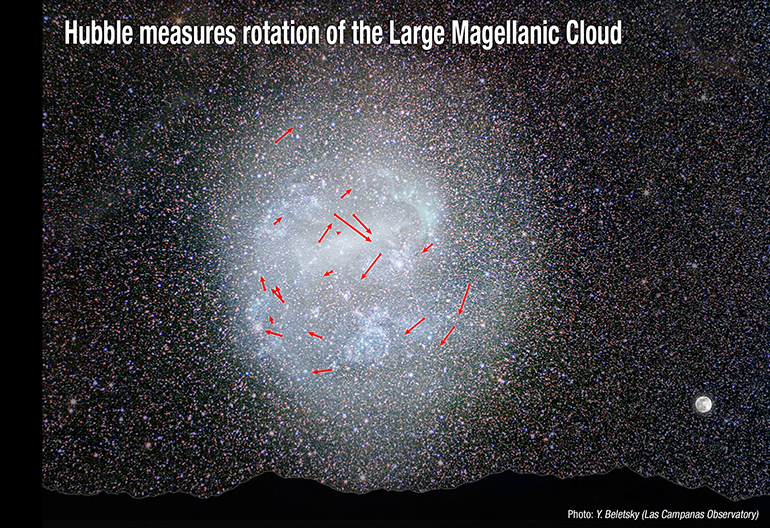For the first time astronomers have precisely measured the rotation rate of a galaxy based on the clock-like movement of its stars. NASA’s H...
For the first time astronomers have precisely measured the rotation rate of a galaxy based on the clock-like movement of its stars.
NASA’s Hubble Space Telescope made the analysis possible. And the results show that a neighboring galaxy—called the Large Magellanic Cloud—completes a rotation every 250 million years. Coincidentally, it takes our sun the same amount of time to complete a rotation around the center of our Milky Way galaxy.

This artist’s illustration shows Hubble measurements of the rotation of the Large Magellanic Cloud (LMC), the nearest normal-sized galaxy to our Milky Way. The LMC appears in the southern-hemisphere night sky, as seen in this ground-based image. (Credit: NASA/ESA)
“Studying this nearby galaxy by tracking the stars’ movements gives us a better understanding of the internal structure of disk galaxies,” Nitya Kallivayalil, an astronomer at the University of Virginia who led the data analysis for the study. “Knowing a galaxy’s rotation rate offers insight into how a galaxy formed, and it can be used to calculate its mass.”
Kallivayalil and astronomer Roeland van der Marel of the Space Telescope Science Institute in Baltimore used Hubble to measure the average motion of hundreds of individual stars in the Large Magellanic Cloud, located 170,000 light-years away. Hubble recorded the stars’ slight movements over a seven-year period. Their findings were published in the Astrophysical Journal.Sideways motions
Disk-shaped galaxies, like the Milky Way and the Large Magellanic Cloud, generally rotate like a carousel. Hubble’s precision tracking offers a new way to determine a galaxy’s rotation by the “sideways” proper motion of its stars, as seen in the plane of sky.
[related]
Astronomers have long measured the sideways motions of nearby celestial objects, but this is the first time that the precision has become sufficient to see another distant galaxy rotate.
For the past century astronomers have calculated galaxy rotation rates by observing a slight shift in the spectrum—called the Doppler effect—of its starlight. On one side of a galaxy’s spinning stellar disk, the stars swinging in the direction of Earth will show a spectral blueshift (the compression of light waves due to motion toward the observer). Stars swinging away from Earth on the opposite side of a galaxy will show a spectral redshift (the stretching of light to redder wavelengths due to motion away from the observer).
The newly measured sideways motions and the Doppler motions measured previously each provide complementary information about the Large Magellanic Cloud’s rotation rate. By combining the results, the Hubble team for the first time obtained a fully three-dimensional view of stellar motions in another galaxy.Not possible without Hubble
Hubble is the only telescope that can make this kind of observation because of its sharp resolution, its image stability, and its 24 years in space.
“This precision is crucial, because the apparent stellar motions are so small because of the galaxy’s distance,” van der Marel says. “You can think of the Large Magellanic Cloud as a clock in the sky, on which the hands take 250 million years to make one revolution. We know the clock’s hands move, but even with Hubble we need to stare at them for several years to see any movement.”
The research team used Hubble’s Wide Field Camera 3 and Advanced Camera for Surveys to observe stars in 22 fields spread across the vast disk of the Large Magellanic Cloud, which appears in the southern night sky as an object about 20 times the angular diameter of the full moon. Arrows on the accompanying image show the predicted motion over the next seven million years, based on the Hubble measurements.How stars move
Each field was chosen to contain not only dozens of Large Magellanic Cloud stars, but also a background quasar, a brilliant beacon of light powered by a black hole in the core of a distant active galaxy. The astronomers needed the quasars as fixed background reference points to measure the extremely subtle motion of the Large Magellanic Cloud stars.
“Because the Large Magellanic Cloud is so nearby, it is a benchmark for studies of stellar evolution and populations,” Kallivayalil says. “For this, it’s important to understand the galaxy’s structure.
“Our technique for measuring the galaxy’s rotation rate using fully three-dimensional motions is a new way to shed light on that structure. It opens a new window to our understanding of how stars in galaxies move.”
In earlier papers, Kallivayalil, van der Marel and their collaborators used Hubble data to show that the Large Magellanic Cloud moves faster around the Milky Way than previously believed. This research has revised understanding of how many times these neighboring galaxies might have met and interacted in the past.
The team next plans to use Hubble to measure the stellar motions in the Large Magellanic Cloud’s diminutive cousin, the Small Magellanic Cloud, using the same technique. The galaxies are interacting, and that study should also yield improved insight into how the galaxies are moving around each other and around the Milky Way.
Source: University of Virginia















COMMENTS